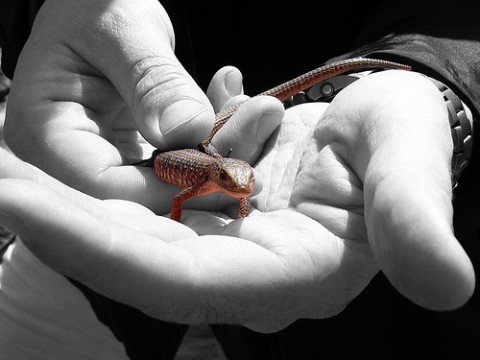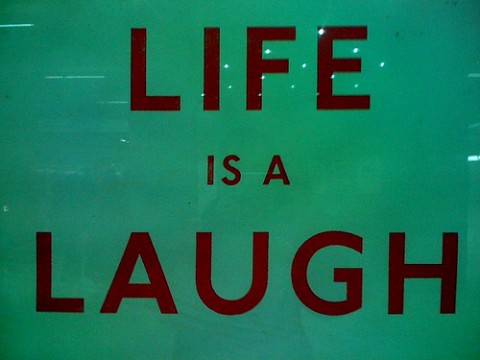April 15, 2010

|Photo by John D. McDonald|http://www.flickr.com/photos/psychoactive/2943294866|
Science has confirmed what many of us feel, that we are each more than one person. We are minds and bodies, left brains and right brains, controlled and automatic responders. This last division is due in part to the fact that we each have more than one brain. Our old reptilian brain is what we can depend on to keep us safe from physical harm most of the time. Our newest brain is what gives birth to the wonders of critical thought and creativity. The amazement I feel about the evolution of our higher thinking is dampened somewhat by my understanding and experience that my multiple brains are not often well coordinated. I walk into a meeting on the one hand (or brain) excited to facilitate, while on the other I am anxious, my more primitive wiring believing there’s a saber toothed tiger in the corner). Welcome to what Seth Godin calls “the lizard” inside.
Read More
April 1, 2010

|Photo by futureshape|http://www.flickr.com/photos/futureshape/2037704163|
(In the spirit of April Fool’s)
A town is hit by a fire that catches in the church district one evening. As the fire spreads, so does word among the members of the neighboring congregations. Before long, people have assembled in front of their respective houses of worship and are deciding what to rescue from inside. A roving reporter goes from group to group to see how they’re responding. She notes that the Catholics have already salvaged the communion cup. Moving to the Episcopal Church, she witnesses a man emerging from smoke to cheers as he hoists the Book of Common Prayer. The reporter heads next to the Unitarians, and as she approaches cannot see a particular object among the group assembled in the street. Observing the expressions on peoples’ faces, she becomes alarmed that someone may still be inside the church, which is on the verge of collapsing. As she gets closer she hears the group in heated debate about who should be on the ad hoc committee to make the final decision about what to rescue . . .
Read More
March 16, 2010

Our friend Larry Dressler just published a book titled “Standing in the Fire” it’s about “leading high-heat meetings with clarity, calm and courage.” Curtis wrote an earlier post inspired by the book. Larry interviewed a wide number of experienced facilitators and I was particularly appreciative of the way he high-lighted the words of our Executive Director, Marianne Hughes.
Referring to what I like to call “the inner condition of the intervener,” Larry says:
Read More
December 31, 2009
One of my favorite poetry finds this year comes from Judy Sorum Brown, whose piece “Fire” ties in nicely with a theme that has been developing for me over the past twelve months. In addition to Judy’s work, I am grateful for the writings of Larry Dressler, which have helped me to embrace the metaphor of “fire tending” (not firefighting) as part of the work we do as leaders, facilitators, consultants, teachers, and perhaps as parents.
Larry’s book Standing in the Fire points out that when we work with groups of people we are to some extent always playing with fire. Fire can burn, of course, but it can also purify and renew, it can serve as fuel, it can warm us, and it can make us uncomfortable enough to get moving. The key is first not to be afraid of the heat. From there it all comes down to the choices we make about how to build and feed the flames in light of what it is we are trying to collectively accomplish.
Read More
December 18, 2009
I attended a powerful, short workshop led by Adrienne Maree Brown (abbreviated from longer trainings she offers) and Invincible on how to facilitate high tension and/or high conflict conversations at the Making Money Make Change conference. Weeks later, ideas and exercises from that workshop are still sticking with me.
Adrienne calls herself a “facilitation evangelist,” because she believes that the world would be transformed if we all practiced facilitation intentionally and were prepared with the tools to do so. I agree with her. And this reminded me of something so basic – facilitation isn’t just for meetings! I hadn’t thought about practicing facilitation in tense conversations with family members, for example, but Adrienne pointed out that facilitation in these and other everyday situations, whether the role is explicit or practiced silently within oneself, can have a profound impact on peoples’ experiences – turning what could be explosive into something more productive.
Read More
November 16, 2009
Recently I was asked for a quote about the messiness of collaboration. In response to the request, I noted that because at IISC we are “Collaboration R Us” we tend not to think about the messiness of collaboration (though we do view messiness as part of any emergent and creative process). Rather we focus on the elegant design and facilitation that will ensure success. The quote that I submitted is the following:
“Collaboration takes more than well-meaning people with good intentions coming together to determine a set of outcomes. Successful collaboration requires solid process design and skillful facilitation. This is what builds the scaffolding for multiple and diverse stakeholders to create a shared vision of impact, agreement on goals and strategies for achieving that impact and a plan for collective action. The process itself is what catalyzes the critical shift of mind and heart from believing that the right answers and expertise are held by a few to an understanding that it is the collective wisdom of the group that determines right action and greater impact.”
Read More
October 15, 2009
Earlier this week, I had the great fortune of hearing Rinku Sen (Applied Research Center), Ellen Gurzinsky (Funders for LGBTQ Issues) and Lori Villarosa (Philanthropic Initiative for Racial Equity) present on “Catalyzing Change and Deepening Racial Justice Impacts” at the Neighborhood Funders Group Annual Conference in New Orleans. It was an exciting session in which they talked about the current racial context in the US and ideas about how grantmaking can be done with a racial justice lens – including real stories about work some specific foundations and groups of foundations are doing. I’ll likely be sharing more over my next few blog posts about grantmaking with a racial justice lens, but wanted to start with some reflections about group processes that came up for me based on their presentation.
As a non-funder, I was listening with an ear toward things that might be applicable to group process as well. Rinku talked about the difference between using a diversity approach and using a racial equity approach to grantmaking, which started me thinking about the difference between these two approaches in stakeholder analyses of multi-stakeholder processes. A diversity approach, as she described it, would be one in which what matters is what the group of people assembled “looks” like – if there are representatives from all the groups affected, etc. – while a racial equity approach might lead one to assemble an entirely different group.
Read More
October 1, 2009
My colleague Linda Guinee recently forwarded a great blog post by Mark McGuinness of Lateral Action . Mark is a consultant in the realm of personal creativity and productivity and he is the father of infant twins. This recent development has him taking a hard look at the advice he often gives others and what holds up under the demands of two babies and sleepless nights. Whether or not you are a parent of young children, it is well worth a read, and I couldn’t agree more with tips such as “let go of routines, focus on systems” and “you can’t please all the people all the time, prioritize the important stuff.” Much of this is in line with Melinda’s post last week (see “Less=More: A Dare”).
Read More
May 15, 2009
During my first year of seminary, I took a Practice of Ministry class in which a series of guest lecturers came to share of their practical experiences from several years in the pastorate. One speaker, whose words I will never forget, was the Rev. Conly Hughes, Jr. of Boston’s Concord Baptist Church. His words of wisdom for a group of neophytes were to illuminate the importance of the pastor’s “ministry of presence”, coupled with her “ministry of absence”. He shared that while it is vital for any conscientious pastor to shepherd in such a way as to be visibly attentive to the day to day, mundane, core issues affecting a community of faith, it is also key that the pastor keeps watch so that her consistency of “presence” does not overwhelm, overpower, nor overbear in a way that stifles the leadership of others, hampers the community’s exercise of agency or which, frankly, allows her to be taken for granted by the people. (At least that’s how I recall the insights I gleaned from his very wise words).
Fast forward: a few years ago, when upon familiarizing myself with Interaction Associates’/Institute’s facilitation methodology, I came across the principle of “Balancing Form and Void”: Creating “Form” is providing participants with a framework or approach for moving toward achieving the desired outcomes. Creating “Void” means stepping back and allowing for open space in the room, both verbally and physically. I immediately noticed the reference to the Biblical text, which comes from the first Creation narrative in the Book of Genesis:
1 In the beginning God created the heavens and the earth. 2 The earth was without form, and void; and darkness was[a] on the face of the deep. And the Spirit of God was hovering over the face of the waters. 3 Then God said, “Let there be light”; and there was light. (NKJV)
As is often the case for me with what I believe to be a Living Text, I gleaned a new insight into its meaning, informed by these pastoral and facilitation contexts: Void – or open space, if you will – as a precursor for even God’s most creative, most productive, most awesome works to…(yep, the “E”-word): emerge.
And so, whether it’s the virtues and vices of “presence”/“absence” in ministry, or the balancing act of any good facilitator vis a vis the “form” and “void” of group processes, I am thinking a lot these days about what this has to do with leadership effectiveness, blind spots (i.e., our ability to discern between what the moment/season/organizational growth cycle calls for), and its connection to organizational possibility, potential, and re-creation.
Co-creators, please — enLighten my world.


